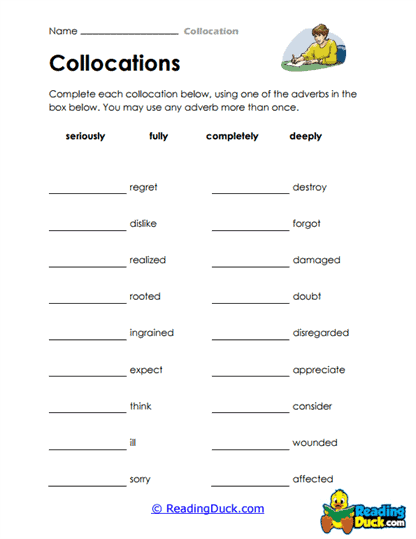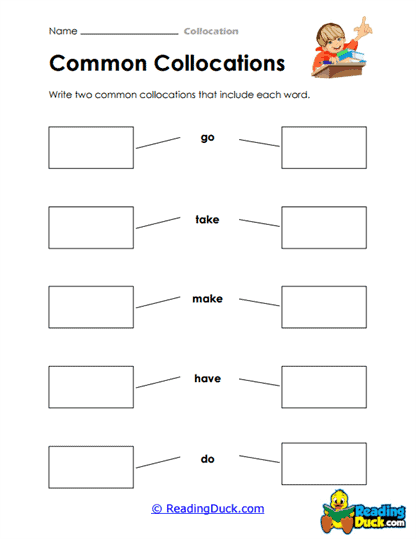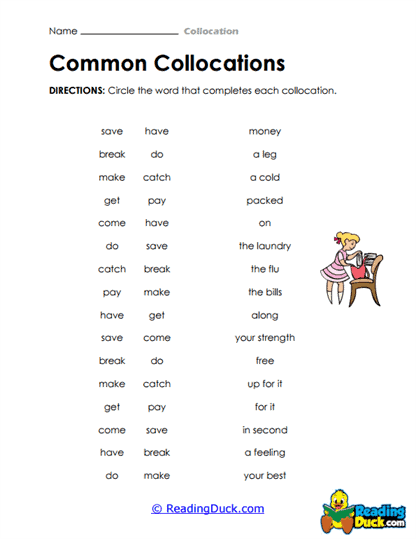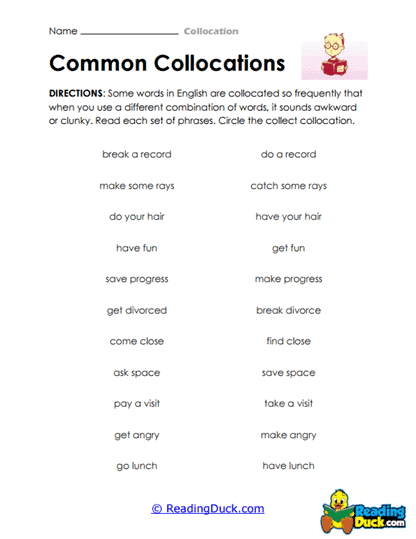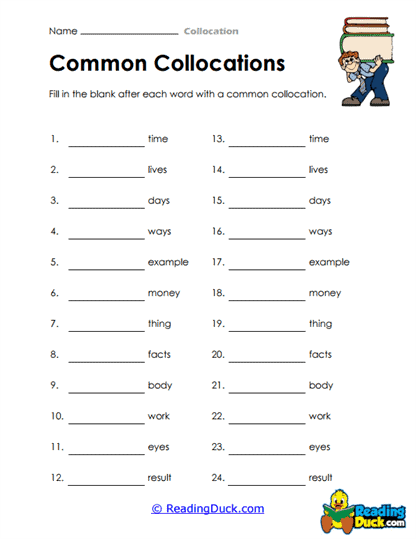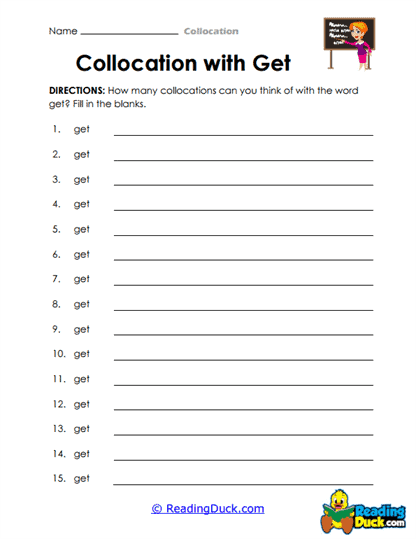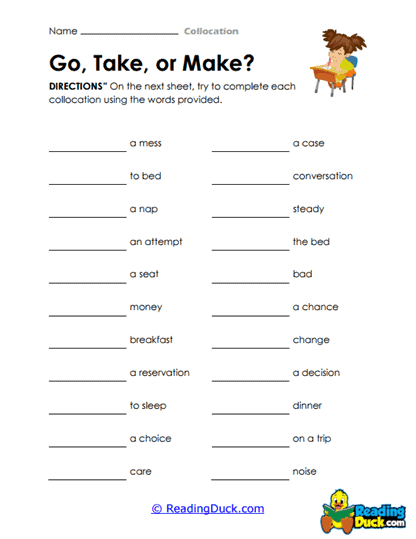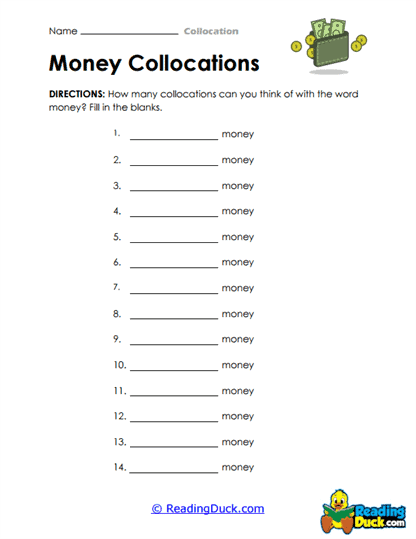Collocation Worksheets
About Our Collocation Worksheets
Our collection of Collocation Worksheets, which falls under the Language category in the Skills section, is designed to help students gain a deeper understanding of collocations and their essential role in fluency and accurate language use. These worksheets provide a structured approach for students to practice and master the combinations of words that naturally occur together in the English language. By developing familiarity with collocations, students enhance their ability to communicate more effectively, understand nuanced meanings, and use language more fluently in both spoken and written forms.
The worksheets are available in PDF format, making them easy to view, download, and print for classroom or home use. In addition, each worksheet comes with a downloadable answer key, making it convenient for educators and learners to check their progress and ensure accuracy as they work through the material.
Understanding Collocations: A Comprehensive Overview
Collocation refers to the habitual pairing of words that frequently appear together in a language. These word combinations follow patterns that sound natural to native speakers but can often pose a challenge for language learners. Understanding collocation is key to using English in a way that sounds fluent and natural. While grammar and vocabulary provide the foundation of language learning, collocations help students combine words in a way that makes their speech and writing sound more polished and professional.
What Is a Collocation?
A collocation is a pair or group of words that are commonly used together in a specific order, resulting in natural-sounding phrases. These word combinations follow patterns that are established over time through regular usage. Unlike random word pairings, collocations have a specific meaning and context when used together, even though the individual words may have distinct meanings on their own.
Common examples of collocations include:
- Make a decision (rather than do a decision)
- Strong coffee (rather than powerful coffee)
- Take a break (rather than have a break)
In these examples, the words that are paired together sound correct to native speakers because they are habitual combinations. For language learners, mastering collocations is essential to achieving fluency and avoiding awkward or incorrect word combinations.
Types of Collocations
There are several types of collocations, depending on the parts of speech involved in the combination. Here are a few examples of the most common types:
- Verb + Noun: Collocations where a verb naturally pairs with a noun.
- Example: Commit a crime (rather than do a crime).
- Adjective + Noun: Collocations where an adjective commonly modifies a specific noun.
- Example: Heavy rain (rather than strong rain).
- Verb + Adverb: Collocations that combine a verb with a specific adverb.
- Example: Run quickly (rather than run fastly).
- Noun + Noun: Collocations where two nouns are regularly used together.
- Example: Traffic jam (rather than traffic block).
These collocation types allow students to understand which word combinations are natural and sound correct in different contexts.
Why Are Collocations Important?
Collocations are crucial for language fluency because they mirror the way native speakers use language. When students learn collocations, they improve their ability to speak and write in a way that sounds natural and fluid. Using the wrong word combinations can make language use seem awkward or incorrect, even if the grammar is otherwise perfect.
The Role of Collocations in Language Use
Collocations are essential in both everyday language and more formal contexts, making them an integral part of fluency and comprehension. Here, we will explore how collocations function in different aspects of communication.
Enhancing Spoken Language
In spoken language, using collocations can make speech sound more authentic and less robotic. Native speakers often rely on collocations without consciously thinking about them, using common word pairings that feel familiar. For example, saying "catch a bus" sounds natural, while "grab a bus" or "take a bus" may sound strange or incorrect. By mastering collocations, learners can converse more fluidly and with greater ease.
Improving Writing Skills
In writing, collocations enhance the richness and clarity of expression. For instance, a student writing an essay might say, "She made a major decision" rather than "She made a big decision." While both phrases are grammatically correct, the former uses the correct collocation and sounds more polished. Understanding collocations enables students to choose words that convey precise meanings and fit together naturally in writing.
Collocations in Different Contexts
Collocations vary based on context, and mastering them can enhance language use in specific situations, including:
- Academic Writing: Collocations like conduct research or reach a conclusion are essential for formal, academic writing.
- Business English: Phrases like meet deadlines or hold a meeting are crucial for professional communication.
- Everyday Conversation: Common expressions like have lunch or make plans are important for everyday communication.
The Importance of Collocations in Literacy Development
Collocations play a pivotal role in developing literacy skills, helping students become more fluent in reading, writing, and speaking. Understanding collocations improves a student's ability to comprehend texts, express ideas clearly, and engage in more sophisticated language use.
Enhancing Reading Comprehension
When students encounter collocations in reading materials, understanding these word pairings can help them comprehend the text more easily. Recognizing familiar collocations allows them to grasp meaning more quickly and accurately. For example, knowing the phrase take advantage helps students understand its contextual meaning rather than interpreting each word individually.
Building Better Writing Skills
Using collocations in writing makes students' work more natural and professional. Instead of relying on basic or incorrect word combinations, students can create more nuanced and impactful sentences. For example, "She made a serious mistake" sounds more precise than "She did a bad mistake." Learning collocations encourages students to write more thoughtfully and with greater fluency.
Improving Speaking Abilities
Mastering collocations in speech leads to more confident and fluid communication. Using the correct word combinations helps students avoid hesitation and makes their speech sound more polished. Knowing which verbs, adjectives, or nouns naturally go together reduces the cognitive load during conversation, allowing for smoother, more spontaneous communication.
Suggestions for Further Practice
To reinforce students' understanding of collocations, educators can integrate additional activities into their lessons, both in the classroom and in homeschool settings. These activities can make learning more engaging and interactive while reinforcing key concepts from the worksheets.
In-Class Activities
- Collocation Matching Game: Create cards with verbs, nouns, or adjectives that students must match to form correct collocations. This activity can be used for students in grades 5-12 and encourages active participation.
- Collocation Storytelling: Have students create short stories using a list of collocations provided by the teacher. This not only reinforces understanding of the word pairings but also enhances creativity and writing skills.
Homeschool Activities
- Collocation Journaling: Encourage students to keep a daily journal where they practice using different collocations in sentences. This helps reinforce the natural use of these word combinations and can be tailored to middle and high school students.
- Collocation Quizzes: For individual study, students can complete quizzes on collocations. Parents or educators can provide prompts that require students to fill in the blanks with the correct collocations, helping them practice in a low-pressure environment.
The Practical Value of Collocation Mastery
In conclusion, mastering collocations is a vital skill for students, as it enhances their overall language proficiency in both spoken and written communication. Collocations not only make language sound more natural but also improve clarity and precision in expressing ideas. Understanding and using collocations correctly allows students to speak and write more fluently, whether in academic, professional, or everyday settings.
The real-world applications of collocation mastery extend beyond the classroom. Whether writing a formal email, delivering a presentation, or engaging in casual conversation, knowing the correct word combinations makes communication smoother and more effective. By incorporating collocations into their language repertoire, students are equipped to handle various communication tasks with confidence and skill, preparing them for success in a variety of real-life contexts.
